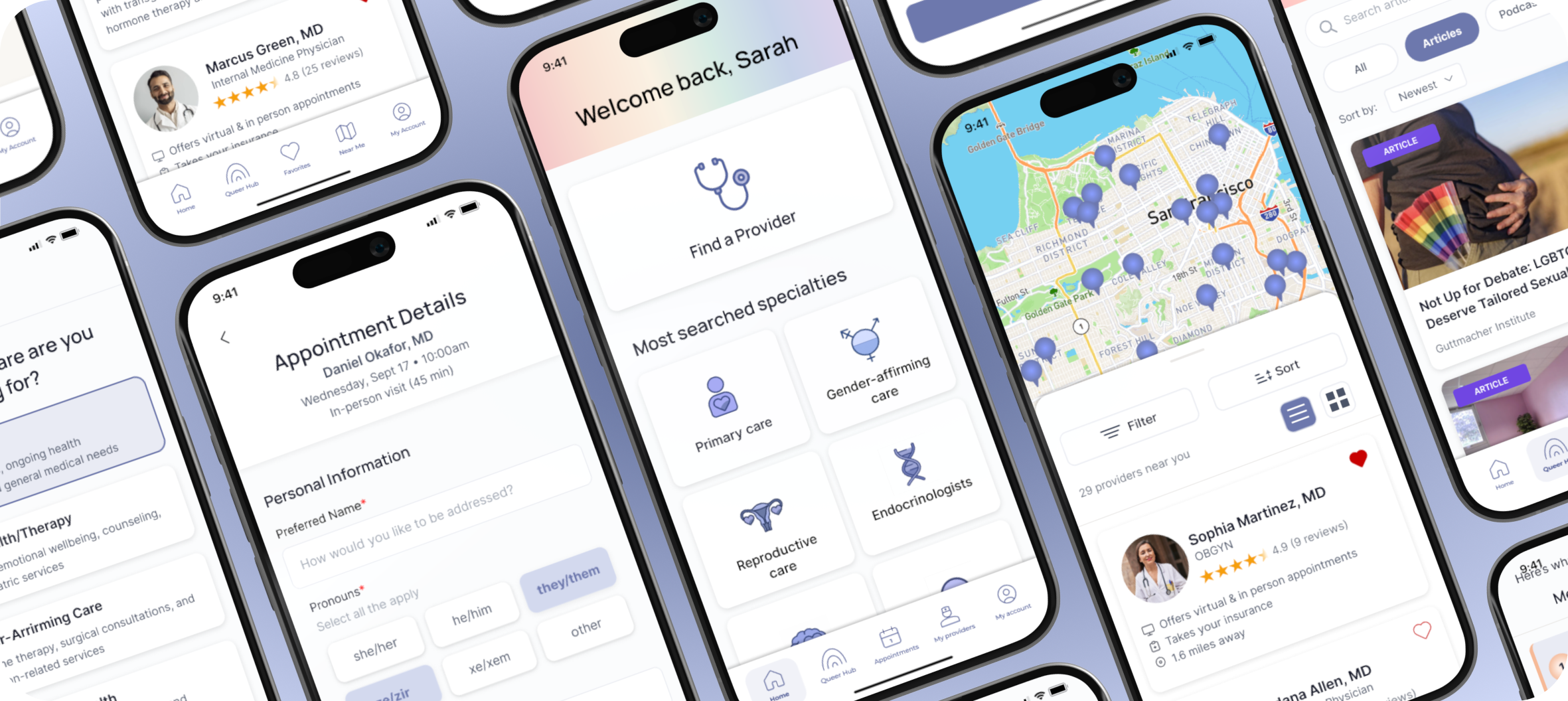Connecting LGBTQ+ folks with affirming healthcare providers who understand their unique needs.
The Challenge
For many LGBTQ+ individuals and families, finding healthcare providers who offer truly inclusive, affirming care remains a significant challenge. Despite growing awareness, many still face discrimination, misunderstanding, or simply a lack of culturally competent care when seeking medical services.
Our research revealed several key pain points:
56% of LGBTQ+ patients reported negative experiences that made them delay seeking necessary care
LGBTQ+ users encounter unexpected bias during appointments
Privacy concerns prevented many from openly asking for recommendations in their networks
What’s my role in all of this?
As an early-stage startup, I've worn many hats to bring Queer Axis Health to life:
Led end-to-end product design and branding, from wireframes to scalable, high-fidelity prototypes
Conducted user research with diverse LGBTQ+ community members
Shaped product strategy based on real user pain points
Collaborated with developers and our legal team to ensure that our designs are feasible and follow healthcare legal requirements
Facilitated user testing sessions to refine our approach
This work is personal. As a queer person who's spent countless hours searching for affirming providers, faced awkward questions in waiting rooms, and started over with new doctors too many times, I understand these challenges firsthand. I've been able to tap into diverse queer networks to understand varied healthcare experiences and needs beyond my own.
This community connection helps ensure our platform serves everyone—from users seeking gender-affirming care, to families trying to conceive.
Defining our strategy
Design without direction is just decoration. That's why I weave strategy into every step of my process. I help our team set clear goals and make decisions that serve both users and our mission.
I ask the hard questions: Who are we really serving? What problem are we actually solving? How will we know we've succeeded? Good strategy turns good design into real impact—and that's ultimately what matters most.
Understanding the laws while designing
Healthcare regulations required careful consideration from the start. Rather than waiting until final designs, I collaborated with our legal team early to ensure compliance. I reframed these requirements as user protection features like clear consent flows, transparent data policies, and secure but usable interfaces.
Good design and good governance go hand in hand.
Designing to help our users
1) Provider vetting - designing for transparency & trust
I designed visible badges and detailed vetting process descriptions because trust drives retention in healthcare.
While other platforms don't disclose their vetting methods, I made transparency a core design principle. We vet physicians for cultural, sexual, and gender competency and clearly communicate this process to users, connecting them with affirming doctors while ensuring healthcare free from bias and discrimination.
2) Secure and discreet booking
My research revealed that LGBTQ+ safety was a top priority for users seeking healthcare. I designed a secure booking system with an optional "discreet communication" feature that allows patients to connect with providers safely. When enabled, doctors omit their names, practices, and specialties from all calls, texts, and emails, giving users control over their privacy and reducing risks in situations where discretion is essential.
3) Inclusive language and provider transparency
My research found that misgendering and exclusionary paperwork were major barriers to care. I designed provider profiles that highlight LGBTQ+ literacy upfront, allowing users to make informed choices before booking. The appointment flow includes diverse gender options and pronoun selections, ensuring patients can accurately represent themselves from their first interaction without having to explain their identity at every visit.
4) AI-powered resource hub
My research showed users needed curated, relevant content without endless searching. I designed a Resource Hub with AI-powered content curation that scans for accurate, affirming articles, podcasts, and blogs covering LGBTQ+ health topics. The system learns from user behavior to deliver personalized recommendations—from coming out conversations to healthcare rights—creating a tailored library of trusted information that stays current without overwhelming users.
5) Professional and community mental health support
Mental health care is deeply personal—especially when you're trying to find someone who understand your lived experience. That's why we are building connections with therapists, counselors, and psychiatrists who are not just "LGBTQ+ friendly" in name, but who bring genuine understanding and specialized training to their practice.
We are also mapping out community support groups (local to their area, or online) where users can find solidarity among peers who share similar journeys.
What did my research tell us?
Numbers tell stories, but people reveal truths.
My research combined academic depth with real human stories. I read A LOT of scholarly articles to understand healthcare barriers, but the real insights came from conversations with people navigating these challenges daily. I designed surveys that asked the right questions and created interview spaces where people felt safe sharing difficult experiences.
Snapshot of research
While my can’t share specifics, I can tell you that patterns emerged: healthcare journeys filled with unnecessary detours, small victories celebrated like marathons won, and workarounds that shouldn't have to exist. These stories weren't just data points—they became our compass, guiding every design decision toward solutions that actually matter.
Where my design started
Initial sketches
From scribbles to solutions—this is where research meets reality. My design process began with quick sketches to explore ideas without getting caught in details too early. These rough concepts evolved through feedback and testing into increasingly refined prototypes.
Refining based on feedback
Each iteration solved a specific challenge: How might we communicate provider competencies clearly? What's are the most important search features? Is our design scope feasible?
Being realistic
This is an example of how strategy and design intersect: after talks with stakeholders, we decided to scrap an entire function: community forum. We have it pinned to revisit later once we have enough users to support that feature.
Setting up design system, reusable components, and style guide
To support a scalable and efficient design workflow, I began by creating the core elements of our system: a robust library of 85+ reusable components, a clear typographic hierarchy, and an accessible color palette. With these foundations in place, our team could prototype and iterate quickly while maintaining visual and functional consistency.
Getting provider buy-in
Introducing a “Featured Provider” card increased engagement by 22%, so I designed a differentiated version using an orange outline and credibility labels. This improved user discovery while also supporting provider conversion, since providers are the primary revenue source.
Addressing abandonment rates
Testing showed users were abandoning bookings at high rates. I removed the bottom navigation from the booking flow to reduce distractions and keep users focused. This single change cut abandonment by approximately 35%, creating a clearer path from provider selection to confirmation.
Snapshot of user testing using Maze
A peek at what user testing told us & how I implemented it:
What next?
We're building momentum behind the scenes! While our digital foundation takes shape, we're focusing on growing our provider network—having meaningful conversations with physicians who share our vision for inclusive healthcare. We're fine-tuning features based on early feedback and scaling our infrastructure to support communities nationwide. Our calendar is marked for launch next year, but the real journey begins after that. This is more than just an app release—it's the start of a movement to transform healthcare experiences for our community.







